The Power of Personalization: Customizable 3D Models Revolutionizing Design
In today’s fast-paced world, customization has become a key priority for consumers. Whether it’s customizing a smartphone case, a pair of sneakers, or even a piece of furniture, people want products that are tailored to their individual tastes and preferences. This demand for personalized products has led to a revolution in the field of design, particularly with the advent of customizable 3D models.
What are Customizable 3D Models?
Customizable 3D models are digital representations of physical objects that can be modified and personalized by users. These models are typically created using 3D modeling software, which allows designers to create intricate and detailed objects with precision. By making these models customizable, designers are able to offer consumers the ability to personalize products to their liking.
One of the key advantages of customizable 3D models is the level of control they offer to both designers and consumers. Designers are able to create a base model of a product and then offer a range of customization options, such as different colors, shapes, and sizes. Consumers can then use these models to create a product that meets their specific needs and preferences.
The Benefits of Customizable 3D Models
There are several benefits to using customizable 3D models in the design process. One of the main advantages is the ability to offer personalized products to consumers. By allowing customers to customize products to their liking, designers can create products that better meet the needs and preferences of their target audience. This can lead to increased customer satisfaction and brand loyalty.
Another benefit of customizable 3D models is the speed and cost-effectiveness of the design process. Traditional methods of product customization can be time-consuming and expensive, as each variation of a product needs to be created individually. With customizable 3D models, designers can create a base model and then simply adjust the parameters to create different variations. This can save time and money, making the design process more efficient.
Additionally, customizable 3D models offer designers greater flexibility and creativity in the design process. By allowing consumers to personalize products, designers can experiment with different shapes, sizes, and materials without the need to create physical prototypes. This can lead to more innovative and unique designs that stand out in a competitive market.
Applications of Customizable 3D Models
Customizable 3D models are being used in a wide range of industries, from fashion and jewelry design to architecture and automotive design. One popular application of customizable 3D models is in the field of 3D printing. By creating digital models that can be easily customized, designers can offer consumers the ability to create one-of-a-kind products that are tailored to their individual needs.
In the fashion industry, customizable 3D models are being used to create personalized clothing and accessories. Designers can create base models of garments and then allow consumers to adjust the sizing, color, and style to create a product that fits their unique preferences. This level of customization can lead to a more sustainable and ethical fashion industry, as consumers are able to purchase products that are tailor-made for them.
In architecture and interior design, customizable 3D models are being used to create custom furniture, lighting fixtures, and other decorative elements. Designers can offer clients the ability to personalize these objects to match their existing decor and aesthetics. This level of customization can help create a cohesive and personalized living or working space that reflects the individual tastes of the client.
The Future of Customizable 3D Models
As technology continues to advance, the possibilities for customizable 3D models are endless. With the rise of virtual and augmented reality, consumers may soon be able to visualize and customize products in real-time, allowing for a more immersive and interactive shopping experience. Additionally, advancements in artificial intelligence and machine learning could enable designers to create highly personalized products that are tailored to an individual’s unique preferences.
Overall, customizable 3D models are revolutionizing the field of design by offering consumers the ability to personalize products to their liking. By harnessing the power of technology, designers can create innovative and unique products that cater to the individual needs and preferences of their target audience. With the continued growth of customizable 3D models, the future of design is sure to be dynamic and personalized.
